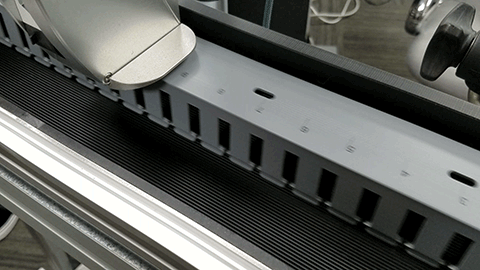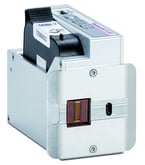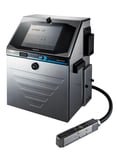
Marking and Coding for PVC Pipe and Other Extruded Plastic Products
Pak-Tec offers industrial coders and printers for a wide range of product identification applications. PVC pipe, flooring, and other plastic extrusion manufacturers are often faced with the decision of whether to use Thermal Inkjet or Continuous Inkjet printers for their product coding needs. Each technology has its unique advantages and ultimately the best solutions is determined by the manufacturers coding requirements and the production line. In this article, we discuss these considerations and the advantages of each coding technology.
Print Technology
 The MarkoprintThermal Inkjet (TIJ) is a high resolution printing technology which uses Hewlett Packard (HP) ½-inch print cartridges with precise ink placement on the substrate.
The MarkoprintThermal Inkjet (TIJ) is a high resolution printing technology which uses Hewlett Packard (HP) ½-inch print cartridges with precise ink placement on the substrate.
 Continuous Inkjet (CIJ) printers, such as Hitachi CIJ Printers, uses a continuous ink circulation system and pump to pulse a steady stream of ink through the printhead and on to the substrate.
Continuous Inkjet (CIJ) printers, such as Hitachi CIJ Printers, uses a continuous ink circulation system and pump to pulse a steady stream of ink through the printhead and on to the substrate.
Speed & Print Quality
Markoprint TIJ can print up to 600 x 600 dpi. With speeds up to 180 meters per minute, Markoprint TIJ printers can easily meet any extrusion line speeds and most packaging lines. This high-resolution allows manufacturers to print crisp, high-contrast barcodes, 2D codes, graphics, logos, and other detailed codes.
CIJ, while exceptionally fast, prints lower resolution dot patterns ideal for alpha-numeric codes but can be limited when used for more demanding graphics.
Throw Distance
 It is always important to consider product handling when evaluating printing technologies. Some production lines have limited print window or inconsistent product handling which may require a longer throw distance.
It is always important to consider product handling when evaluating printing technologies. Some production lines have limited print window or inconsistent product handling which may require a longer throw distance.
When printing on non-porous surfaces such as PVC pipes, Markoprint TIJ can easily print 5 mm away from the product while still delivering sharp, high-contrast codes. Typically extrusion lines have uniform spacing and product handling so this typically is not a concern.
Alternatively, Hitachi CIJ printers have a much further throw distance and can easily print beyond 25mm from the product.
Cleanliness
Markoprint creates no mess thanks in part to its self-contained inkjet cartridge. Replacing HP cartridges is simple and mistake-proof.
Older 'pour-in' CIJ models require operators refill ink reservoirs by transferring ink from the bottle to the tank. This can lead to operator errors and spills; however, new models have resolved this through the use of self-sealing bulk cartridges and 'smart bottles.'
Maintenance
The use of disposable HP style cartridges make Markoprint TIJ printers virtually maintenance free. With each new cartridge you get a new printhead, all for less than $100. If you are tight on maintenance support, this is a clear win for TIJ systems.
CIJ printers of the past did require routine cleaning and maintenance; however, new systems provide self cleaning print heads and ultra reliable pumps. In some harsh or dusty environments, CIJ printers can provide better uptime than other printing technologies and Hitachi CIJ printers are typically considered one of the most reliable print systems available.
Inks
Markoprint has specialized inks with fast dry time 1 to 2 seconds, typically fast enough for most extrusion processes. Solvent ink colors include black, red, blue, light blue, green, yellow, and white. Do you require different print colors on different products? Change over couldn't be easier; just swap out the print cartridge.
Continuous Inkjet (CIJ) printers have always enjoyed a wider range of inks and solvents compared to that of TIJ printers; however, the CIJ ink circulation system doesn't easily allow you to change out ink color. If dry time is an important consideration for your application, CIJ technologies have a clear advantage with a virtually instant dry time.
Costs
Markoprint has a compelling advantage over CIJ in terms of upfront capital costs. The trade-off is in the cost of ink. Cost-per-print of CIJ systems is less than half that of TIJ. As mentioned earlier in this article, TIJ ink cartridges includes a printhead and these are designed to be disposable. While this certainly helps with maintenance, there is a lot of cost in production of these cartridges.
While upfront capital cost of CIJ systems are more than TIJ, the superior efficiency of a CIJ circulation system and bulk ink cartridge really cut down on ink cost and overall cost-per-print.
Summary
Looking for high-resolution printing with virtually no maintenance, easy change-over, and low upfront cost - Markoprint Thermal Inkjet systems might be the way to go.
Do you need a robust solution for a high volume application where cost-per-print is critical - Continuous Inkjet may be the right fit.
Next Steps
Contact Pak-Tec for an complete application analysis. We will work with you to outline your requirements, conduct a comprehensive report on total cost of ownership, and help guide you to a winning solution.
Contact us today or visit our website more information on industrial marking, coding, and end-of-line packaging solutions.
